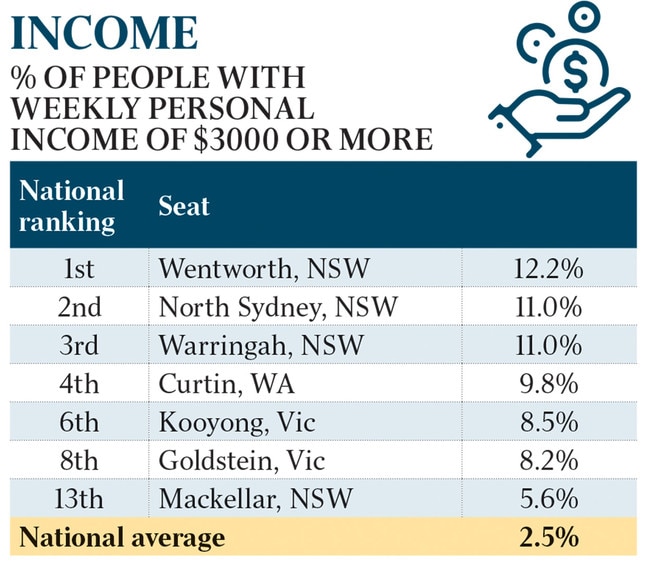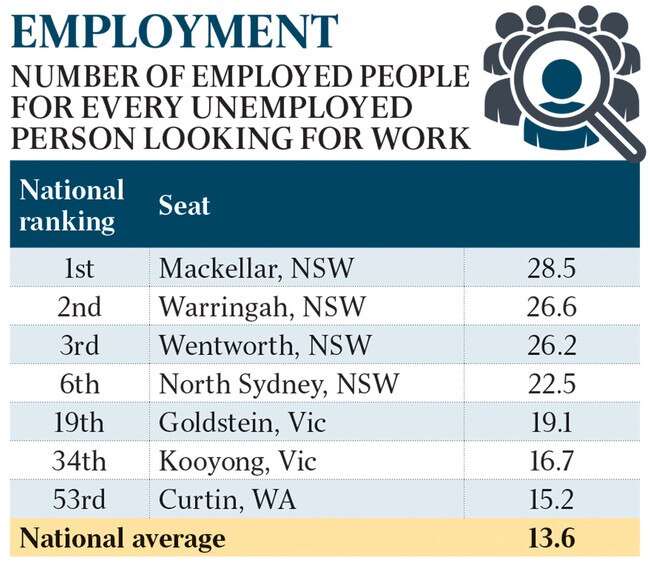Teals: tertiary educated, affluent, liberal
They came in their Range Rovers and Jimmy Choos for a political reset. The teals triumphed on the back of disaffected Liberal voters in Australia’s wealthiest and most educated electorates.

It was the rebellion of the top 1 per cent.
They came in their Range Rovers and their Jimmy Choos: polished, professional and primed for a political reset.
The teals claimed victory on the back of disaffected Liberal voters in the nation’s wealthiest, most educated electorates.
From harbourside Vaucluse in Wentworth (median house price, $8.2m) to genteel Hawthorn in Kooyong (Scotch College fees: $36,000 a year) voters in the teal seats are, statistically at least, a cut above the average.
Wentworth, Kooyong, North Sydney, Goldstein, Mackellar, Curtin and Warringah all have significantly higher than average weekly household incomes.

In Wentworth, where Dave Sharma was unseated by Allegra Spender, 12.2 per cent of the population had a weekly personal income of greater than $3000, according to the latest census data. That’s almost five times the national average of 2.5 per cent.
It’s 11 per cent in North Sydney and Warringah, where businesswoman Kylea Tink claimed victory over Trent Zimmerman and former barrister Zali Steggall retained the seat against Liberal candidate Katherine Deves.
All the teal seats have at least three times the number of voters earning more than $3000 a week except Mackellar on Sydney’s northern beaches, where general practitioner Sophie Scamps has defeated incumbent Jason Falinski, which has more than double.
However, in good news for Mackellar residents, the electorate has more employed people for every unemployed person looking for work (28.5 per cent) than any other electorate in the country. The national average is 13.6 per cent.
In Kooyong, where treasurer Josh Frydenberg has conceded defeat to paediatric neurologist Monique Ryan, 39 per cent of the population is university educated with a bachelor degree or higher. In the rest of the country it’s fewer than 18 per cent.

North Sydney tops the national charts on university education, with 41.4 per cent of the population, with Wentworth not far behind on 39.6 per cent.
Simon Kuestenmacher from the Demographics Groups said all seven of the electorates shared characteristics of high education and wealth.
The Greens didn’t appeal in these electorates because voters were older, highly educated and in established jobs, Mr Kuestenmacher said, but the Liberals missed the boat on climate. “The easiest voter for the Liberal Party to win over would be a green voter because Liberal and Greens voters are both rich,” he said. “It’s just that the Greens voters tend to be rich young people mostly that care about the environment.”
Australian Development Strategies founder John Black said underpinning the electoral success of the teals was the growth in professional women over the past 10 or 15 years who wanted to see themselves represented politically.
“They’re [women] used to running firms and things and they want to have a say on the Liberal side in terms of what happens to them politically in terms of their representation,” said the former Labor senator.

RedBridge director Kosmos Samaras said demographic churn and increasing medium residential development, which housed medium-income professionals, meant traditional Liberal strongholds were increasingly diverse.
“Wentworth has more in common now with Sydney, which is Tanya Plibersek’s electorate,” said Mr Samaras, a former campaign director for Victorian Labor.
Former Victorian Liberal senator Richard Alston denied the teals were disaffected Liberals, with the possible exception of Allegra Spender due to her family’s connections.
“Higgins [Melbourne] complicates your analysis because there wasn’t a teal candidate there and yet we still lost to Labor,” he said.
Mr Kuestenmacher said votes to the major parties had been steadily declining since 1990.
“In 30 years’ time we went from 2 per cent of people voting for third parties to 33 per cent voting for third parties,” he said.
“That’s huge. Everyone writing about the demise of the two-party system is probably spot-on.”



To join the conversation, please log in. Don't have an account? Register
Join the conversation, you are commenting as Logout